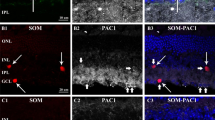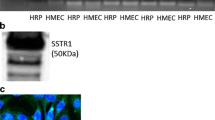Abstract
Neoangiogenesis is a response to retinal hypoxia that is inhibited by somatostatin (SRIF) through its subtype 2 receptor (sst2). Using a mouse model of hypoxia-induced retinopathy, we investigated whether inhibition of adenylyl cyclase (AC) is involved in SRIF anti-angiogenic actions. Hypoxia increased AC responsiveness in wild type (WT) retinas and in retinas lacking sst2, but not in sst2-overexpressing retinas. Hypoxia also altered AC isoform expression with different patterns depending on sst2 expression level. The AC VII isoform mRNA and protein resulted the most affected. Indeed, in hypoxia AC VII expression was enhanced in WT retinas and it was further increased in sst2-lacking retinas, whereas in sst2 overexpressing retinas the increase of AC VII was lower than in WT retinas. These data suggest an involvement of AC/cAMP in mediating both hypoxia-evoked retinal neoangiogenesis and SRIF protective actions. The AC VII isoform is a candidate to a main role in these mechanisms.



Similar content being viewed by others
References
Campochiaro PA (2004) Ocular neovascularisation and excessive vascular permeability. Expert Opin Biol Ther 4:1395–1402
Gariano RF, Gardner TW (2005) Retinal angiogenesis in development and disease. Nature 438:960–966
Baldysiak-Figiel A, Lang GK, Kampmeier J et al (2004) Octreotide prevents growth factor-induced proliferation of bovine retinal endothelial cells under hypoxia. J Endocrinol 180:417–424
Grant MB, Mames RN, Fitzgerald C et al (2000) The efficacy of octreotide in the therapy of severe nonproliferative and early proliferative diabetic retinopathy: a randomized controlled study. Diabetes Care 23:504–509
Simo R, Lecube A, Sararols L et al (2002) Deficit of somatostatin-like immunoreactivity in the vitreous fluid of diabetic patients: possible role in the development of proliferative diabetic retinopathy. Diabetes Care 25:2282–2286
Davis MI, Wilson SH, Grant MB (2001) The therapeutic problem of proliferative diabetic retinopathy: targeting somatostatin receptors. Horm Metab Res 33:295–299
Grant MB, Caballero S (2002) Somatostatin analogues as drug therapies for retinopathies. Drugs Today 38:783–791
Garcia de la Torre N, Wass JA, Turner HE (2002) Antiangiogenic effects of somatostatin analogues. Clin Endocrinol 57:425–441
Sall JW, Klisovic DD, O’Dorisio MS et al (2004) Somatostatin inhibits IGF-1 mediated induction of VEGF in human retinal pigment epithelial cells. Exp Eye Res 79:465–476
Dasgupta P (2004) Somatostatin analogues: multiple roles in cellular proliferation, neoplasia, and angiogenesis. Pharmacol Ther 102:61–85
Weckbecker G, Lewis I, Albert R et al (2003) Opportunities in somatostatin research: biological, chemical and therapeutic aspects. Nat Rev Drug Discov 2:999–1017
Pavan B, Fiorini S, Dal Monte M et al (2004) Somatostatin coupling to adenylyl cyclase activity in the mouse retina. Naunyn-Schmiedebergs Arch Pharmacol 370:91–98
Olias G, Viollet C, Kusserow H et al (2004) Regulation and function of somatostatin receptors. J Neurochem 89:1057–1091
Hanoune J, Defer N (2001) Regulation and role of adenylyl cyclase isoforms. Annu Rev Pharmacol Toxicol 41:145–174
Beitz E, Volkel H, Guo Y et al (1998) Adenylyl cyclase type 7 is the predominant isoform in the bovine retinal pigment epithelium. Acta Anat 162:157–162
Abdel-Majid RM, Tremblay F, Baldridge WH (2002) Localization of adenylyl cyclase proteins in the rodent retina. Brain Res Mol Brain Res 101:62–70
Amano H, Ando K, Minamida S et al (2001) Adenylate cyclase/protein kinase A signaling pathway enhances angiogenesis through induction of vascular endothelial growth factor in vivo. Jpn J Pharmacol 87:181–188
Sakurai S, Alam S, Pagan-Mercado G et al (2002) Retinal capillary pericyte proliferation and c-Fos mRNA induction by prostaglandin D2 through the cAMP response element. Invest Ophthalmol Vis Sci 43:2774–2781
Casibang M, Purdom S, Jakowlew S et al (2001) Prostaglandin E2 and vasoactive intestinal peptide increase vascular endothelial cell growth factor mRNAs in lung cancer cells. Lung Cancer 31:203–212
Schwarz N, Renshaw D, Kapas S et al (2006) Adrenomedullin increases the expression of calcitonin-like receptor and receptor activity modifying protein 2 mRNA in human microvascular endothelial cells. J Endocrinol 190:505–514
Dal Monte M, Petrucci C, Cozzi A et al (2003) Somatostatin inhibits potassium evoked glutamate release by activation of the sst2 somatostatin receptor in the mouse retina. Naunyn-Schmiedebergs Arch Pharmacol 367:188–192
Dal Monte M, Petrucci C, Vasilaki A et al (2003) Genetic deletion of somatostatin receptor 1 alters somatostatinergic transmission in the mouse retina. Neuropharmacology 45:1080–1092
Casini G, Dal Monte M, Petrucci C et al (2004) Altered morphology of rod bipolar cell axonal terminals in the retinas of mice carrying genetic deletion of somatostatin subtype receptor 1 or 2. Eur J Neurosci 19:43–54
Dal Monte M, Cammalleri M, Martini D et al (2007) Anti-angiogenic role of somatostatin receptor 2 in a model of hypoxia-induced neovascularization in the retina: results from transgenic mice. Invest Ophthalmol Vis Sci 48:3480–3489
Kreienkamp HJ, Akgun E, Baumeister H et al (1999) Somatostatin receptor subtype 1 modulates basal inhibition of growth hormone release in somatotrophs. FEBS Lett 462:464–466
Allen JP, Hathway GJ, Clarke NJ et al (2003) Somatostatin receptor 2 knockout/lacZ knockin mice show impaired motor coordination and reveal sites of somatostatin action within the striatum. Eur J Neurosci 17:1881–1895
Smith LE, Wesolowski E, McLellan A et al (1994) Oxygen-induced retinopathy in the mouse. Invest Ophthalmol Vis Sci 35:101–111
Bradford MM (1976) A rapid and sensitive method for the quantitation of microgram quantities of protein utilizing the principle of protein–dye binding. Anal Biochem 72:248–254
Brown BL, Ekins RP, Albano JD (1972) Saturation assay for cyclic AMP using endogenous binding protein. Adv Cyclic Nucleotide Res 2:25–40
Wang X, Seed B (2003) A PCR primer bank for quantitative gene expression analysis. Nucleic Acids Res 31:e154
Rozen S, Skaletsky H (2000) Primer3 on the WWW for general users and for biologist programmers. Methods Mol Biol 132:365–386
Livak KJ, Schmittgen TD (2001) Analysis of relative gene expression data using real-time quantitative PCR and the 2(-Delta Delta C(T)) method. Methods 25:402–408
Tsai WH, Koh SW, Puro DG (1987) Epinephrine regulates cholinergic transmission mediated by rat retinal neurons in culture. Neuroscience 22:675–680
Colas B, Valencia AM, Prieto JC et al (1992) Somatostatin binding and modulation of adenylate cyclase in ovine retina membranes. Mol Cell Endocrinol 88:111–117
Masmoudi O, Gandolfo P, Tokay T et al (2005) Somatostatin down-regulates the expression and release of endozepines from cultured rat astrocytes via distinct receptor subtypes. J Neurochem 94:561–571
Watts VJ, Neve KA (2005) Sensitization of adenylate cyclase by Galpha i/o-coupled receptors. Pharmacol Ther 106:405–421
Takeo S, Niimura M, Miyake-Takagi K et al (2003) A possible mechanism for improvement by a cognition-enhancer nefiracetam of spatial memory function and cAMP-mediated signal transduction system in sustained cerebral ischaemia in rats. Br J Pharmacol 138:642–654
Zhao Y, Xu D, Quaegebeur JM et al (2002) Expression of adenylyl cyclase V/VI mRNA and protein is upregulated in cyanotic infant human myocardium. Pediatr Cardiol 23:536–541
Cooper DM, Crossthwaite AJ (2006) Higher-order organization and regulation of adenylyl cyclases. Trends Pharmacol Sci 27:426–431
Palmer GC (1985) Cyclic nucleotides in stroke and related cerebrovascular disorders. Life Sci 36:1995–2006
Rocha-Singh KJ, Honbo NY, Karliner JS (1991) Hypoxia and glucose independently regulate the beta-adrenergic receptor-adenylate cyclase system in cardiac myocytes. J Clin Invest 88:204–213
Kuroko Y, Yamazaki T, Tokunaga N et al (2007) Cardiac epinephrine synthesis and ischemia-induced myocardial epinephrine release. Cardiovasc Res 74:438–444
Acknowledgments
This work was supported by the Italian Ministry of University and Research (MUR, PRIN, grant 2005052312) and the Fondazione Cassa di Risparmio di Cento. We thank G. Bertolini (University of Pisa, Italy) for assistance with mouse colonies.
Author information
Authors and Affiliations
Corresponding author
Rights and permissions
About this article
Cite this article
Ristori, C., Ferretti, M.E., Pavan, B. et al. Adenylyl Cyclase/cAMP System Involvement in the Antiangiogenic Effect of Somatostatin in the Retina. Results from Transgenic Mice. Neurochem Res 33, 1247–1255 (2008). https://doi.org/10.1007/s11064-007-9576-6
Received:
Accepted:
Published:
Issue Date:
DOI: https://doi.org/10.1007/s11064-007-9576-6




